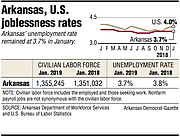Arkansas' unemployment rate was unchanged at 3.7 percent in January compared with the same month last year, the U.S. Bureau of Labor Statistics said Monday.
The national unemployment rate was 4 percent in January.
The bureau made revisions to the civilian labor force going back to 2010 and to Arkansas' nonfarm payroll jobs going back to 1976.
The revisions, which are reported annually in March, were more extensive than usual, said Michael Pakko, chief economist at the Arkansas Economic Development Institute at the University of Arkansas at Little Rock.
"The interesting thing about the most recent revisions is that they have both smoothed and increased the growth Arkansas has seen over the past couple of years," Pakko said.
The revisions appeared to show that Arkansas had a much better 2018 than was first thought, said Mervin Jebaraj, director of the Center for Business and Economic Research at the University of Arkansas, Fayetteville.
Original statistics released during the year indicated that Northwest Arkansas, central Arkansas and Jonesboro were accounting for all the job growth in the state, Jebaraj said.
The revisions subtracted a few hundred jobs from those three metro areas and added them to rural areas of the state, Jebaraj said. Previously, there was no job growth reported in Arkansas' rural areas, Jebaraj said.
The revisions show that smaller metropolitan areas, such as Hot Springs and Fort Smith, were also growing, he said.
"On average, the revisions added about 2,300 jobs in the nonmetro areas," Jebaraj said. "[Before the revisions], that number was negative."
According to the original figures, the state was adding fewer than 10,000 jobs, Jebaraj said.
"Now it's much higher than that," Jebaraj said.
In the revised figures, the state is seeing growth of about 13,200 jobs over the year, Jebaraj said.
Over a two-year period, from December 2016 to December 2018, the original calculations showed Arkansas' nonfarm payroll employment grew 1.9 percent, Pakko said. With the revisions, the growth was 2.5 percent, Pakko said.
The revisions in the state's unemployment rates were not significant, Pakko said. For example, the December 2018 unemployment rate was revised to 3.7 percent, up from the original rate of 3.6 percent.
In the January figures, eight industry sectors in the state added jobs, two lost jobs and one was unchanged.
Manufacturing saw the biggest gain, adding 3,100 jobs in January compared with the year before. There were 3,700 jobs added in durable goods manufacturing and 600 jobs lost in nondurable goods manufacturing.
"The year-over-year increase in Arkansas manufacturing jobs is the second-highest of the 21st century, eclipsed only by the annual gain through January 2015," said Greg Kaza, executive director of the Arkansas Policy Foundation in Little Rock. "Arkansas manufacturing employment has expanded 7 percent since reaching its cyclical trough in July 2013."
The number of construction jobs in Arkansas grew by 1,400 from January 2018 to January of this year.
Forty-four states added construction jobs, according to an analysis by the Associated General Contractors of America. Association officials cautioned that the employment gains may not last without an increase in the number of people trained for construction careers.
"Contractors began 2019 by adding employees in nearly all parts of the country," said the group's chief economist, Ken Simonson. "These figures are consistent with the optimism contractors expressed about workloads and hiring plans in our association's recent survey. But finding workers to execute those projects is likely to be an ongoing challenge."
Professional and business services, which lost 300 jobs in the past year, seems to have slowed down, Pakko said. The revised data showed that the decline was more than anticipated, Pakko said.
Iowa and New Hampshire had the lowest unemployment rates in the country at 2.4 percent, followed by North Dakota and Vermont at 2.5 percent each, and Hawaii at 2.7 percent.
Alaska had the highest rate at 6.5 percent, followed by West Virginia at 5.2 percent, Arizona and New Mexico at 5.1 percent each, and Louisiana at 4.9 percent.
Business on 03/12/2019
